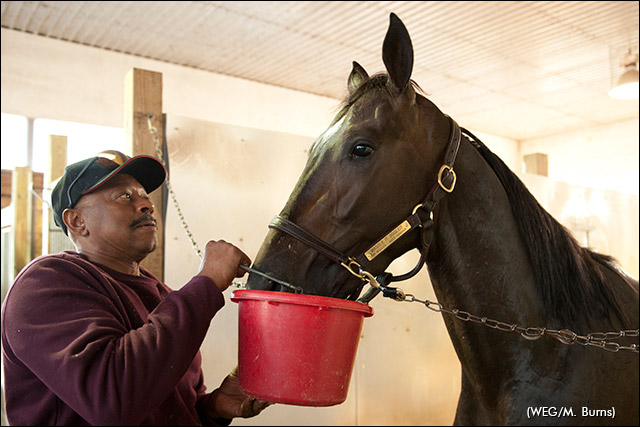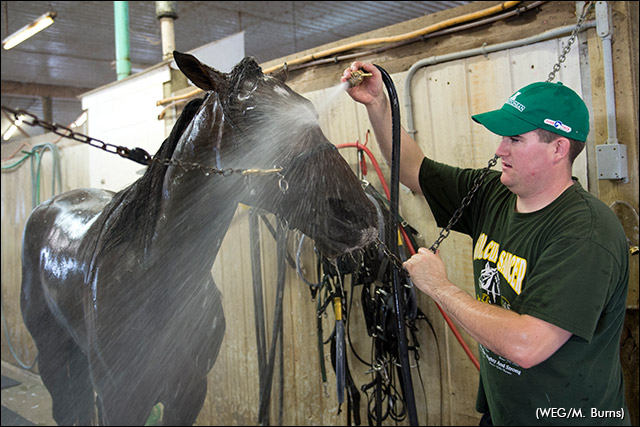When people hear “E. coli” (full name Escherichia coli) thoughts may drift to reports of waterborne illness such as the Walkerton outbreak of 2000. In that tragedy, the municipal water supply had been contaminated with E. coli O157:H7 (Enterohemorrhagic E. coli or EHEC) originating from nearby cattle farms, magnified by heavy rains and flooding and which overwhelmed the water treatment system. So, it’s not surprising that when E. coli has been recovered from a horse that becomes seriously ill or dies, people consider a contaminated water source to be the cause. Unfortunately this conclusion can negatively impact the reputation of the facility owner and their bottom line.

E. coli is a bacterium normally found in the manure of all animals, including horses, and is very common in the environment. There are many different strains of E. colisome of which can cause severe illness in people and young livestock. Fortunately, no strains of E. coli specifically from horses have been known to cause illness in people or other species of animals nor have strains from other species of animals been known to cause disease in horses.
E. coli is frequently found in manure samples from both sick and normal horses. In a study by researchers at the University of Guelph (Schoster et al. 2012), E. coli was isolated in 77.3% of fecal samples obtained from normal horses on 25 Ontario farms and recovered from each horse at least once. E. coli is one of several species of bacteria that make up the normal composition of the intestinal contents or microflora of the horse and is found in foals as early as one day of age. Since E. coli is shed in the horse’s manure it is considered to be present in all places exposed to manure, particularly the stall. As part of the normal microflora of the intestinal tract, it provides health benefits with respect to digestion and immune function, however, E. coli is also an “opportunistic” pathogen and can be associated with infections as well. Because it is present in the horse’s direct environment, it can contaminate wounds as well as complicate respiratory, reproductive and urinary tract infections. Foals can be particularly susceptible to blood infections with E. coli if they fail to ingest colostrum and have a weakened immune system.
Having E. coli in the normal intestinal tract can be beneficial, however, when the gut becomes diseased, severe health issues can develop. Stress from sickness, disease, transportation, surgery etc. and/or treatment with medications, especially antibiotics, can alter the number and type of bacterial populations within the gut. Some bacterial populations will die and be replaced by others and may result in colic, diarrhea and, in some situations, rapid death.
In the latter scenario, toxins (endotoxins) are released from Gram-negative bacteria such as E. coli when they reproduce quickly or die. The endotoxin can then enter the blood stream through areas of unhealthy gut leading to signs of shock and, in some cases, organ failure and death. It is not the E. coli per se that causes the death of the horse but the initial medical problem or treatment that leads to a change in E. coli populations and the release of endotoxin that may lead to the animal’s demise.
E. coli can be found if one looks for it! Testing of horse manure and intestinal contents for bacteria will often reveal E. coli but it is usually an incidental finding. As well, one will find E. coli in the horse’s environment. It has not been proven to be harmful to horses when found in the water, but its presence may indicate a more serious water issue.

So if E. coli in the water is generally not harmful to horses, is it worthwhile testing the water and, if so, for what?
Coliform testing: Coliforms are bacteria (including E. coli ) that are normally found in human and animal feces/manure but also in soil and water. Since coliforms can also be found in plants and the environment, the presence of coliforms does not necessarily indicate fecal contamination (if fecal contamination of a water supply was specifically of concern, fecal coliform testing can be requested). The presence of coliforms, however, does indicate that the water supply is not secure and could be contaminated by disease causing organisms for which further testing may be warranted such as for those causing Salmonellosis and blue green algae toxicosis.
Total Dissolved Solids (TDS): Other contaminants of surface water such as road salt and fertilizers can enter unsecured water supplies. To help identify the presence of some of these contaminants water can be tested for total dissolved solids (TDS) which is a measure of mainly inorganic salts (e.g. calcium, magnesium, sulfate, potassium, sodium, magnesium, zinc, copper, iron etc.) and is used as a guide for the suitability of water for livestock. The individual ions can also be measured. The total dose of these ions in the feed and water should be calculated to ensure levels are not in the toxic range (ask your veterinarian or nutritionist for help). This is especially important when managing equine athletes who receive a variety of electrolyte and mineral supplements.
Best practices for horse facilities including training centres and racetracks involve testing the water at a minimum once yearly, but should ideally be done during each season and more often if there are times of heavy rainfall or drought conditions. As well, water should be tested if there is a change in color, cloudiness, smell, willingness of horses to drink, suspicion of a water-borne disease, after water system maintenance and if there is a sudden change in the performance of a group of horses.
For coliform levels, water testing can be performed by the company that services the facility’s well or through agricultural laboratories such as the Agriculture and Food Laboratory at the University of Guelph. This laboratory can also perform testing for total dissolved solids, individual ions, as well as bacteria and fungi in the water. Testing water for human drinking (or potable) water can only be done through the local public health unit.
The views presented in Trot Blogs are those of the author and do not necessarily represent those of Standardbred Canada.

